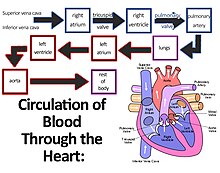Can any one explain me the working,structure and functions of heartwith the help of a diagram?please
In human beings, the heart is a muscular organ. It is divided into four chambers – right auricle, right ventricle, left auricle, and left ventricle. The walls of these chambers are made up of a special muscle called myocardium, which contracts continuously and rhythmically to distribute blood to all the body cells.

Working of heart
- The heart has superior and inferior vena cava. They carry deoxygenated blood from the upper and lower regions of the body respectively and supply the deoxygenated blood to the right auricle of the heart.
- The right ventricle contracts and passes the deoxygenated blood into the two pulmonary arteries, which pumps it to the lungs where the blood is oxygenated. From the lungs, the pulmonary veins transport the oxygenated blood to the left atrium of the heart.
- The left atrium contracts and through the auriculo-ventricular aperture (bicuspid valve), the oxygenated blood enters the left ventricle.
- The blood passes to aorta from the left ventricle. The aorta gives rise to many arteries that distribute the oxygenated blood to all the regions of the body.
- Since the blood goes twice through the heart, it is known as double circulation.


